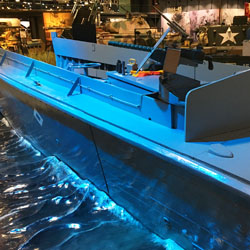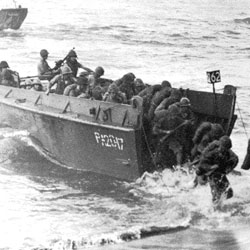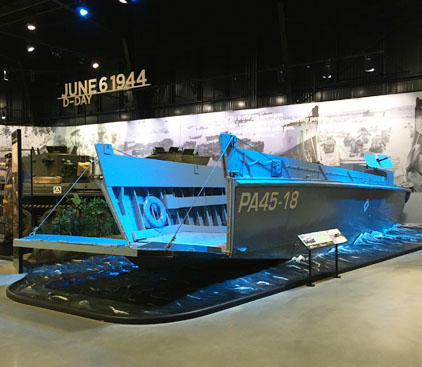The Higgins LCVP, (Landing Craft, Vehicle and Personnel) affectionately known as the Higgins Boat, was one of the main amphibious landing craft for the United States Navy (USN) during the course of World War Two. The Higgins Boat made possible many amphibious assaults undertaken by the Navy during the war; the most notable of which is the D-Day landing, known as Operation Overlord, in Normandy, France on June 6th, 1944. They were just used in France, however. Their usage was also vital in the campaigns in Italy, North Africa, and Japan.
The LCVP was designed by Andrew Higgins, a small boat designer who lived in Louisiana and developed oil prospecting ships for a living. In 1938 he correctly guessed that the United States would both need small boats, of which he claimed the USN “doesn’t know one damn thing about” and that war would cause a great shortage of steel. He acted on both of these hunches by buying the whole stock of mahogany produced by the Philippines in 1939 and fortifying his company. Higgins won a contract from the Navy to produce small wooden boats for them at the onset of the second World War. The USN was dissatisfied with the first boat he developed for them, called the LCP, because the design required infantry to jump over the side of the boat and didn’t allow for the transportation of vehicles. The boat designer remedied this by removing the bow and tacking on a draw ramp, and the LCVP was born. Higgins’ and other American factories managed to produce over 23,000 LCVP’s from 1942 to 1945.
The Higgins LCVP clocks in at 36’ 3” in length and 10’ 10” in width, with a 3’ draft aft and a 2’ 2” draft forward. The shallow draft allows the Higgins to effortlessly push up high in the water and up on the shore which, coupled with a pulley operated draw ramp, makes landfall for whatever a given Higgins was carrying a very fast process. Speaking of, the LCVP had numerous payloads that were common to it. If it was carrying personnel, the Higgins held 36 fully armed soldiers. Aside from men, Higgins boats were also known to carry a fully loaded Jeep, a small truck unit, or 8100 lbs. of ammunition and other supplies.
LCVPs were operated by four-man crews: A coxswain, an engineer, a bowman, and a sternman. It was the duty of the coxswain to pilot the boat and to maintain the auxiliary equipment. The engineer was tasked with maintaining the boat’s engines and operating the winch that dropped the ramp when it was time to offload. The bowman operated the starboard gun and moved to the front of the ship to assist the engineer in dropping the ramp. The sternman operated the port gun and assisted the engineer in pulling the ramp up after landing had occurred. The sternman also acted as the signal man. Each position in the crew was interchangeable between soldiers except for the engineer because the engineer required special training.
President Dwight D. Eisenhower attributed the Higgins LCVP with being one of the main reasons the Allies won the war. Without it, he says, the Allied strategy for the war would be completely different. Without the Higgins, amphibious landings would have been nearly impossible to pull off, greatly devaluing the efficacy of Navy transports and would have left the Allies with a much more difficult time finding ways to put troops on the ground.
The Higgins boat on display here at the American Heritage Museum was discovered in Normandy, which means it was most likely used during the D-Day invasion, and has been expertly restored by the North Carolina Maritime Museum.








